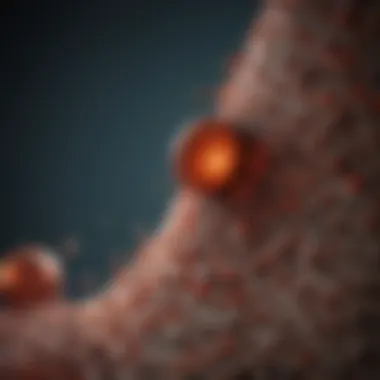Melanoma and BRAF: An In-Depth Analysis of Mutations


Intro
Melanoma is a form of skin cancer that stems from melanocytes, the pigment-producing cells. Its aggressive nature and increasing incidence has made it a focal point in cancer research. A significant factor in melanoma's pathogenesis is the mutation of the BRAF gene, which is involved in the regulation of cell growth. This article aims to provide clarity on the interplay between melanoma and BRAF mutations, which have significant implications for diagnosis and treatment strategies. By examining existing literature and current advancements, this discussion will serve as a reference for those engaged in the study and treatment of this malignancy.
Background and Context
Overview of the research topic
The landscape of melanoma treatment has evolved considerably, particularly with the identification of BRAF mutations as critical contributors to the disease. BRAF mutations primarily occur in the V600E region of the gene, driving the proliferation of melanoma cells. These mutations impact the mitogen-activated protein kinase (MAPK) signaling pathway, which is essential for cellular growth and survival. The prevalence of these mutations varies, but they are present in about 40–60% of melanoma cases, highlighting their significance in the development of targeted therapies.
Historical significance
Historically, melanoma was associated with poor prognosis, often leading to high mortality rates. However, advancements in molecular biology have facilitated the identification of genetic markers, such as BRAF mutations. This discovery has led to innovative therapeutic strategies, particularly the development of BRAF inhibitors like vemurafenib and dabrafenib, which have transformed treatment paradigms. The journey from limited treatment options to the availability of targeted therapies illustrates the importance of genetic research in oncology.
Key Findings and Discussion
Major results of the study
Recent studies have established that patients with BRAF mutations tend to respond favorably to targeted therapies compared to those without these mutations. It has been observed that effective treatment leads to significant improvements in overall survival rates. Furthermore, combination therapies, which may include MEK inhibitors alongside BRAF inhibitors, show promise in enhancing therapeutic outcomes by overcoming resistance mechanisms.
Detailed analysis of findings
The experience of clinicians and patients reveals the multifaceted nature of melanoma treatment. BRAF mutations have not only informed treatment decisions but also prompted reevaluation of diagnostic methods. For example:
- Genetic Testing: Advanced techniques like next-generation sequencing have better identified patients eligible for targeted therapies.
- Surveillance: There is an ongoing need for continued monitoring of patients post-treatment to assess for recurrence or progression of the disease.
Emerging research further emphasizes the necessity of personalized treatment approaches guided by genetic profiles. The overall clinical implications point to a paradigm shift, where understanding the underlying genetics of melanoma is vital for effective intervention.
"The interplay between melanoma and BRAF mutations exemplifies how genetic insights can transform clinical outcomes."
Prelims to Melanoma
Melanoma is a form of skin cancer originating from melanocytes, the pigment-producing cells of the skin. Understanding melanoma is crucial for both healthcare professionals and researchers as it presents significant challenges in terms of diagnosis and treatment. The incidence of melanoma has been steadily rising, making it a public health concern in many countries. This section provides insights into the definition, types, epidemiology, and risk factors associated with melanoma.
Definition and Types of Melanoma
Melanoma is primarily characterized by the uncontrolled growth of melanocytes. This aggressive cancer can lead to serious health complications if not detected early. There are several types of melanoma, including:
- Superficial spreading melanoma: This is the most common type, usually appearing as a flat or slightly raised discolored area.
- Nodular melanoma: Often more aggressive, it typically presents as a raised, dark lesion.
- Lentigo maligna melanoma: Often associated with sun-damaged skin, this type appears as a large, flat freckle that changes over time.
- Acral lentiginous melanoma: This rare type occurs on the palms of the hands, soles of the feet, or under the nails, more common in individuals with darker skin.
Recognizing these types is essential for proper clinical management and prognosis.
Epidemiology of Melanoma
The epidemiology of melanoma indicates its increasing prevalence. Globally, melanoma incidents have surged, especially among Caucasians. According to study results, the likelihood of developing melanoma is influenced by geographic regions. For instance, higher incidence rates are recorded in Australia and New Zealand. Statistically, the chance of surviving melanoma is significantly better when diagnosed early. Frequent monitoring and education about skin changes are vital for effective intervention.
Risk Factors Associated with Melanoma
Several factors increase the likelihood of developing melanoma. Understanding these risk factors can facilitate early detection and prevention efforts:
- Ultraviolet (UV) exposure: Excessive sun exposure or tanning bed use increases risk.
- Skin type: Individuals with fair skin, freckles, and light hair have a higher risk.
- Family history: Genetics play a crucial role; a family history of melanoma raises individual susceptibility.
- Previous melanoma: A history of melanoma increases the risk of recurring cancer.
- Immune suppression: Individuals with weakened immune systems, such as organ transplant recipients, are at heightened risk.
"Melanoma represents a dual concern for both individuals and healthcare systems due to its lethality and rising costs associated with its treatment."
Understanding BRAF Mutations


Understanding BRAF mutations is critical in the context of melanoma because these genetic alterations significantly influence the biological behavior of the cancer. With over 40% of melanoma cases linked to BRAF mutations, it is essential for both diagnosis and treatment strategies. An in-depth comprehension of BRAF helps in the development of targeted therapies, which have improved patient outcomes in this aggressive skin cancer. This section explores the fundamental aspects of the BRAF gene, its activation process, and the types of mutations found in melanoma.
BRAF Gene Overview
The BRAF gene encodes a protein involved in sending signals within cells, which helps control cell growth and division. BRAF is part of the RAS-RAF-MEK-ERK signaling pathway, which is crucial for regulating normal cell functions. Mutations in the BRAF gene can lead to excessive signaling, promoting uncontrolled growth typical in cancers.
The most common BRAF mutation, V600E, results in the substitution of valine with glutamic acid at position 600. This mutation occurs in the majority of melanoma cases. Understanding the BRAF gene's structure and function provides insight into its role in melanoma and the potential for targeted therapies that inhibit its aberrant activity.
Mechanisms of BRAF Activation
BRAF mutations activate its protein product, altering the downstream signaling pathways. When the BRAF protein is mutated, it becomes constantly activated, leading to overactivation of the MEK-ERK pathway. This activation bypasses the regulatory mechanisms and results in enhanced cell proliferation and survival.
The mechanisms of BRAF activation-specific to melanoma include:
- Conformational Changes: Mutations can cause the BRAF protein to adopt a conformation that is constitutively active.
- Dimerization: Mutant BRAF can form dimers with other BRAF proteins or other kinases, amplifying the signaling pathway.
- Negative Regulation Bypass: The usual negative feedback from other signaling molecules is disrupted, sustaining the pathway's activation.
These mechanisms underline the critical need for targeted treatment strategies aimed at inhibiting BRAF activity in melanoma patients.
Types of BRAF Mutations in Melanoma
Several types of mutations within the BRAF gene have been identified in melanoma, each varying in frequency and impact. The primary mutations include:
- V600E: The most prevalent mutation, accounting for about 90% of BRAF mutations in melanoma. It leads to persistent activation of the BRAF protein.
- V600K: A less common mutation, similar to V600E, but exhibits slight differences in its signaling capacity and response to therapies.
- V600R: Another variant that has been reported, though less frequently.
- Non-V600 Mutations: Include a variety of alterations that are less common but can also play a role in melanoma development and response to treatment.
Recognition of these mutations is fundamental for personalized therapeutic approaches, ensuring that targeted therapies can be effectively administered as part of the treatment regimen for melanoma patients.
"Understanding BRAF mutations provides invaluable information for tailoring treatments for melanoma patients, significantly impacting their prognosis."
In summary, a detailed understanding of BRAF mutations in melanoma is pivotal for developing effective diagnostic and therapeutic strategies. It not only helps in identifying patients who might benefit from BRAF inhibitors but also enriches the overall understanding of melanoma pathology.
Pathophysiology of Melanoma
Understanding the pathophysiology of melanoma is crucial in elucidating how this aggressive skin cancer develops and progresses. Melanoma originates from the pigment-producing cells called melanocytes, which can become malignant primarily due to genetic mutations, environmental factors, and immune evasion mechanisms. The intricate interplay of these factors defines not only the tumor characteristics but also its response to treatment. Grasping these mechanisms provides insights into potential therapeutic strategies and the overall clinical management of the disease.
Role of BRAF in Melanoma Development
The BRAF gene encodes a protein that is part of the MAPK signaling pathway, essential for regulating cell division and growth. In approximately 40 to 60 percent of melanoma cases, mutations in the BRAF gene lead to constitutive activation of this pathway, driving uncontrolled proliferation of melanocytes.
Key points regarding the role of BRAF include:
- Common BRAF Mutations: The most frequent mutation, BRAF V600E, converts the protein into an active form, continuously signaling for cell growth.
- Impact on Tumor Behavior: BRAF mutations are associated with more aggressive melanoma types. This is critical for understanding prognosis.
- Targeting BRAF: The presence of a BRAF mutation guides therapeutic decisions, as targeted therapies like vemurafenib and dabrafenib have been developed to inhibit the aberrant signaling.
"Understanding BRAF's role is key for melanoma prognosis and treatment strategies."
Interaction between BRAF and Other Signaling Pathways
BRAF does not act in isolation; its interactions with various signaling pathways are significant. Other pathways, especially the RAS-RAF-MEK-ERK pathway, play a pivotal role in cellular responses to external stimuli. When BRAF is mutated, it can cause dysregulation that influences other growth factors and oncogenic signals, amplifying the effects of tumorigenesis.
Important interactions to note include:
- NRAS Mutations: Often coexist with BRAF mutations, leading to a more complex tumor biology.
- PI3K Pathway: The BRAF mutation may also alter the PI3K-AKT pathway, affecting cell survival and metabolism, which can further enhance malignancy.
- Tumor Microenvironment: The dysregulated signaling affects how melanoma cells interact with their microenvironment, which is crucial for metastasis and immune evasion.
Tumor Microenvironment in Melanoma
The tumor microenvironment is the surrounding cellular environment of a tumor, including immune cells, blood vessels, fibroblasts, and the extracellular matrix. In melanoma, the tumor microenvironment plays a vital role in promoting or inhibiting tumor growth and response to therapy.
Significant aspects of the tumor microenvironment include:


- Immune Evasion: Melanoma cells develop strategies to evade immune recognition, often leading to a suppressive environment that aids in cancer progression.
- Angiogenesis: The tumor microenvironment supports the formation of new blood vessels to supply nutrients to the tumor, facilitated by factors secreted by melanoma cells.
- Stroma Interaction: The interaction between melanoma cells and fibroblasts can enhance tumor aggressiveness, indicating a complex relationship that affects treatment responses.
In summary, the pathophysiology of melanoma encompasses the roles of genetic mutations, cellular signaling, and the tumor microenvironment. Understanding these elements is crucial for developing innovative therapeutic approaches and improving the management of melanoma.
Diagnosis of Melanoma
The diagnosis of melanoma is a critical aspect of effectively managing this aggressive form of skin cancer. Early detection significantly influences treatment outcomes and survival rates. Therefore, understanding the clinical presentation, diagnostic techniques, and the role of BRAF testing is essential for healthcare professionals. This section provides detailed insights into how melanoma is diagnosed, emphasizing the importance of each component in ensuring timely and accurate treatment.
Clinical Presentation of Melanoma
Melanoma often presents as changes in existing moles or the emergence of new pigmented lesions. Physicians are trained to look for specific characteristics, commonly summarized by the ABCDE criteria:
- Asymmetry: One half is unlike the other half.
- Border: Irregular, scalloped, or poorly defined edges.
- Color: Varied from one area to another; shades of tan, brown, black; sometimes white, red, or blue.
- Diameter: Larger than 6mm, although melanomas can be smaller.
- Evolving: Changes in size, shape, color, or elevation, or new symptoms such as bleeding, itching, or crusting.
While these features guide initial assessment, physical exams must be complemented by patient history and risk factor analysis. Individuals with a history of excessive sun exposure, fair skin, or a family history of melanoma have a higher likelihood of developing this disease.
Diagnostic Imaging Techniques
After an initial clinical evaluation, various imaging techniques assist in melanoma diagnosis. These methods include:
- Dermatoscopy: A non-invasive technique that uses a dermatoscope for magnified visualization of pigmented lesions. It enhances the detection of subtle signs of melanoma that may not be visible to the naked eye.
- Ultrasound: Helps evaluate deeper structures, especially when lymph node involvement is suspected. This imaging modality aids in staging by determining lymph node size and presence of metastasis.
- Magnetic Resonance Imaging (MRI): Used for assessing the extent of disease in cases where melanoma is suspected to have spread to the brain or other organs.
These imaging modalities enable healthcare providers to accurately assess whether a lesion is melanoma and its potential spread, facilitating appropriate treatment planning.
BRAF Testing in Melanoma Diagnosis
BRAF testing has emerged as a vital tool in diagnosing melanoma. As many melanomas harbor BRAF mutations, testing for these alterations offers significant clinical insight. The primary benefits include:
- Targeted Therapy: Discovering BRAF mutations allows for personalized treatment options. Patients with specific mutations can be treated with targeted therapies such as vemurafenib or dabrafenib, which can effectively inhibit tumor growth.
- Prognostic Information: The presence of BRAF mutations often correlates with the aggressiveness of the disease, aiding in risk stratification and management decisions.
Therapeutic Approaches
The therapeutic approaches for melanoma, particularly in the context of BRAF mutations, are of exceptional significance. These strategies are designed not only to remove tumors but also to target specific pathways that contribute to the disease's growth and spread. Innovations in therapy have substantially improved the prognosis of many patients who previously had limited options. Incorporating various methods, such as surgery, targeted therapy, and combination therapies, allows for individualized treatment plans that maximize efficacy and minimize adverse effects.
Surgical Interventions for Melanoma
Surgical intervention remains a cornerstone in the treatment of melanoma, especially in its early stages. The primary objective of surgery is to excise the tumor along with a margin of healthy tissue. This approach reduces the risk of recurrence and provides the best chance for a cure.
When the melanoma is localized, procedures like wide excision become standard. Here, the surgeon removes not only the melanoma but also surrounding skin to achieve clear margins. In cases where melanoma has spread to lymph nodes, lymphadenectomy may be required, which entails removing affected nodes.
Moreover, surgical techniques have evolved. Techniques such as Mohs micrographic surgery enable the precise removal of skin cancer while preserving healthy tissue. Studies have shown that this method can lead to higher cure rates with fewer recurrences. Some challenges in surgical treatments include:
- Wound healing issues
- Cosmetic outcomes post-surgery
- Recurrence of melanoma
Targeted BRAF Inhibitors
Targeted BRAF inhibitors represent a significant advancement in the therapeutic landscape for patients with melanoma harboring BRAF mutations. Drugs like vemurafenib and dabrafenib have demonstrated effectiveness in inhibiting the mutated BRAF protein, thereby impeding cell proliferation and inducing apoptosis in tumor cells.
These inhibitors are particularly beneficial for patients with unresectable or metastatic melanoma characterized by BRAF V600 mutations. While the initial responses can be impressive, there are concerns regarding resistance that develop over time. Mechanisms of resistance may include:
- Secondary mutations in the BRAF pathway
- Activation of alternative signaling pathways
Despite these challenges, the benefits of using targeted BRAF inhibitors are evident, including improved overall survival rates and progression-free survival. The integration of these therapies is crucial in the management of advanced melanoma and has prompted ongoing research for better therapeutic strategies.
Combination Therapies in Melanoma Treatment


Combination therapies represent a promising approach to enhance the efficacy of melanoma treatment, particularly in cases with BRAF mutations. By combining targeted therapy with other modalities, including immunotherapy or additional targeted agents, clinicians aim to tackle the complexities of melanoma biology more effectively.
For example, the combination of dabrafenib with trametinib, a MEK inhibitor, has shown improved outcomes compared to monotherapy. This synergistic effect can delay the onset of drug resistance and sustain treatment response longer. Furthermore, by employing immune checkpoint inhibitors alongside BRAF inhibitors, there is potential to invigorate the immune response against melanoma.
However, combination treatments also come with their own set of challenges. Issues can arise, such as:
- Increased toxicity
- Complexity in treatment regimens
- Variability in patient response
In summary, each therapeutic approach offers unique advantages and warrants careful consideration in clinical settings. The landscape of melanoma treatment is continuously evolving, and understanding these methodologies is pivotal for improving patient outcomes in a challenging disease.
Current Research Trends
Research in the field of melanoma and BRAF mutations is rapidly evolving. Current research trends are crucial in illuminating new avenues for diagnosis and treatment. Focusing on BRAF, these trends lead to better understanding of the mutation's implications. This knowledge can drive more effective therapeutic strategies. As melanoma's aggressive nature persists, staying updated with innovations is essential for healthcare professionals.
Emerging BRAF Mutations as Therapeutic Targets
BRAF mutations are at the forefront of targeted therapies in melanoma. Recent studies indicate that not only the common V600E mutation is relevant but also other variants such as V600K and V600R show significant clinical relevance. By identifying different mutations, researchers can tailor specific therapies more effectively. This specificity can increase progression-free survival rates for patients.
“Understanding the diversity of BRAF mutations can reshape the melanoma therapeutic landscape.”
Therapeutic agents like vemurafenib and dabrafenib directly target these mutations. Using these targeted agents has become standard in managing advanced melanoma. However, resistance to therapy remains a challenge. Continuous research aims to understand mechanisms of resistance and discover new drugs that could overcome it. Thus, identification of emerging BRAF mutations promises to bolster treatment efficacy.
Innovations in Immunotherapy for Melanoma
Immunotherapy for melanoma is changing how this cancer is treated. Immune checkpoint inhibitors like pembrolizumab and nivolumab have garnered attention because they unleash the immune system against tumor cells. Research is evaluating their effectiveness in patients harboring BRAF mutations. Trials combining checkpoint inhibitors with BRAF inhibitors show promise in enhancing treatment outcomes.
The identification of specific biomarkers can optimize patient selection for these therapies. Recent efforts focus on genetic profiling to better predict responses. This tailoring of treatment could deliver improved responses and lessen adverse effects. As innovative combinations and new therapeutic agents emerge, they reshape the treatment landscape.
Future Directions in Melanoma Research
Looking ahead, melanoma research is poised to expand. Focus areas include exploring personalized medicine and the potential of combination therapies. Understanding the tumor microenvironment is becoming increasingly important, as it can influence treatment effectiveness. Advances in genomics and proteomics are expected to yield new insights.
Another promising area is the role of artificial intelligence in diagnosis and treatment planning. Utilizing AI tools could lead to early detection and personalized treatment recommendations. Collaborative efforts across different research institutions are essential for this advancement. Open discussions and sharing of data can pave the path for more robust findings and improve patient outcomes.
Closure
Melanoma poses significant challenges in oncology, particularly given its aggressive nature and the intricate molecular mechanisms underpinning its development. This article focuses particularly on BRAF mutations, which are prevalent in melanoma and have profound implications for diagnosis and treatment.
Summation of BRAF's Role in Melanoma
BRAF functions as a key player in the mitogen-activated protein kinase (MAPK) signaling pathway. Mutations in the BRAF gene, especially the BRAF V600E variant, lead to uncontrolled cellular proliferation and resistance to apoptosis. This mutation is implicated in approximately 40-60% of cutaneous melanoma cases. The activation of BRAF promotes oncogenic signaling, resulting in tumorigenesis.
Understanding the role of BRAF in melanoma allows healthcare professionals to evaluate the molecular pathology of the disease more accurately. It has facilitated the development of targeted therapies such as Vemurafenib and Dabrafenib, which specifically inhibit the mutant BRAF protein, offering improved outcomes for patients. Therefore, the BRAF mutation not only serves as a biomarker for a subtype of melanoma but also guides therapy choices.
Implications for Future Research
Future research in melanoma and BRAF mutations must focus on multiple fronts. Firstly, investigations should delve deeper into the mechanisms leading to BRAF mutation-acquired resistance to therapy. Several patients show resistance to BRAF inhibitors over time. Furthermore, combing BRAF inhibitors with other therapeutic agents, such as MEK inhibitors, may enhance treatment efficacy.
Moreover, studies should assess the role of other genetic mutations and environmental factors in conjunction with BRAF mutations. As the understanding of these interactions grows, it may enable precision medicine strategies tailored to individual patients' genetic profiles.
In addition, the integration of multidisciplinary approaches, including immunotherapy and targeted therapies, will likely be pivotal in overcoming the limitations posed by single-agent therapies. By focusing on innovative research and comprehensive treatment strategies, the future landscape of melanoma management will evolve, leading to better prognostic outcomes for patients.
Benefits of Strong References
- Evidence-Based Practice: Strong references support evidence-based practices in both research and clinical applications. This allows healthcare providers to optimize treatment protocols informed by the most recent discoveries.
- Interdisciplinary Relevance: Melanoma affects various fields including dermatology, oncology, and molecular biology. Quality references reflect the interdisciplinary nature of this research area, ensuring that readers from different backgrounds can appreciate the broader implications.
- Trend Tracking: Citing up-to-date research helps in tracking the evolving landscape of melanoma treatment. As new techniques and therapies emerge, references enable readers to stay informed about cutting-edge innovations.
- Critical Thinking and Analysis: Engaging with references encourages critical evaluation of the literature and promotes advanced analytical skills. Readers, particularly in academic and professional settings, can better assess the strengths and weaknesses of studies in the context of BRAF mutations and melanoma.
Considerations for Reference Selection
When selecting sources for this article, it is important to consider both the relevance and the recency of the material.
- Relevance: Sources should specifically pertain to melanoma and BRAF. This ensures that the discussion remains focused and insightful.
- Recency: Given the rapid advancements in cancer research, older references may not provide the most accurate picture. Thus, it is vital to include recent studies and guidelines, particularly from recognized authorities in the field.
"References not only enhance the credibility of the work but also empower the audience with the knowledge to explore new questions."







